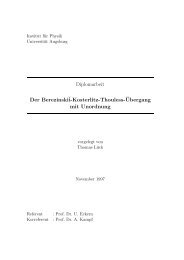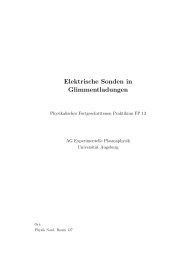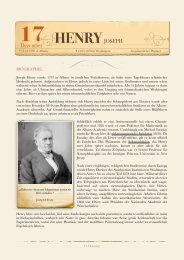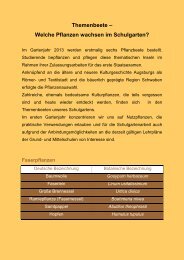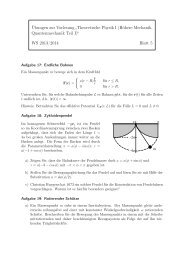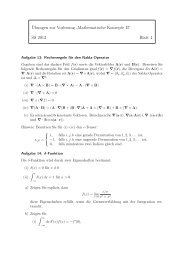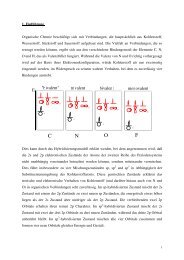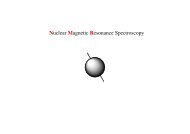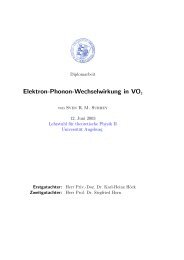Driven Quantum Systems - Institut für Physik
Driven Quantum Systems - Institut für Physik
Driven Quantum Systems - Institut für Physik
Create successful ePaper yourself
Turn your PDF publications into a flip-book with our unique Google optimized e-Paper software.
270 <strong>Driven</strong> <strong>Quantum</strong> <strong>Systems</strong><br />
5.5 Numerical approaches to periodically driven<br />
quantum systems<br />
Except for the special cases discussed in Sect. 5.4, exactly solvable quantum systems<br />
with explicitly time-dependent interaction potentials are extremely rare. As demonstrated<br />
with (5.83), this is true already for the periodically driven two-level-system in<br />
a linearly polarized monochromatic field [11] for which no exact closed form solution<br />
can be found. Thus, we generally have to invoke numerical procedures.<br />
5.5.1 Method of Floquet matrix<br />
Since the Hamiltonian H(x, t) and the Floquet modes are time-periodic, we can expand<br />
the Floquet solutions into the Fourier vectors |n〉, n =0,±1,±2,..., such that 〈t|n〉 =<br />
exp(inωt),<br />
Φ α (x, t) =<br />
∞∑<br />
n=−∞<br />
c n α (x)exp(inωt). (5.116)<br />
The functions c n α(x) can be expanded in terms of a complete orthonormal set {ϕ k (x),<br />
k =1,...,∞}, yielding in terms of the unperturbed eigenfunctions of H 0 (x),<br />
Φ α (x, t) =<br />
∞∑<br />
∞∑<br />
k=1 n=−∞<br />
c n α,kϕ k (x)exp(inωt), (5.117)<br />
with c n α,k = 〈ϕ k|c n α 〉. Hence, in terms of the kets |ϕ k〉, 〈x|ϕ k 〉 = ϕ k (x), the Floquet<br />
equation (5.14) reads<br />
∞∑<br />
∞∑<br />
k=1 n=−∞<br />
Hc n α,k |ϕ k〉 exp(inωt) =<br />
∞∑<br />
∞∑<br />
k=1 n=−∞<br />
ɛ α c n α,k |ϕ k〉 exp(inωt). (5.118)<br />
Setting 〈ϕ k |〈m| ≡〈ϕ k m|and multiplying (5.118) with 〈ϕ j m| exp(−imωt) fromtheleft,<br />
yields after a time-average over one period of driving, the system of equations<br />
∞∑ ∞∑<br />
〈〈ϕ j m|H|ϕ k n〉〉c n α,k = ɛ αc m α,j . (5.119)<br />
n=−∞ k=1<br />
Here we used the scalar-product notation in (5.19). With the definition<br />
∫ T<br />
H m−n = 1 dtH(t)exp[−i(m − n)ωt], (5.120)<br />
T 0<br />
one finds the Floquet-matrix representation for (5.119),<br />
∞∑ ∞∑<br />
〈〈ϕ j m|H F |ϕ k n〉〉c n α,k = ɛ α c m α,j, (5.121)<br />
k=1 n=−∞<br />
with the Floquet matrix defined by<br />
〈〈ϕ j m|H F |ϕ k n〉〉 ≡ 〈ϕ j |H m−n |ϕ k 〉 + n¯hωδ n,m δ j,k . (5.122)



